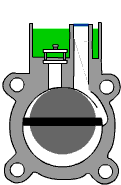Rotary Vane Pumps: Technical Notes
This Page From: Lesker Vacuum Systems

|
The rotary vane pump's hollow body has a rotating cylinder mounted off-axis. In the rotor, two diametrically opposed radially directed vanes are spring-loaded to force contact with the pump body. Since the rotor is positioned off-axis, its motion causes the volume between the vanes and the body to vary during each half turn. The gas inlet port is so positioned that the volume behind the last vane to pass increases, allowing gas to expand into it until the next vane passes. As the volume exposed to the inlet increases, the volume trapped between the vane and the exhaust port decreases. In a single stage pump, the exhaust port has a valve connected to the atmosphere. In a two stage pump, the first stage's exhaust connects directly to the second stage's inlet. Gas exits the pump by bubbling up through the pump's oil reservoir. In either version, the gas is compressed against the final exhaust valve until it exceeds atmospheric pressure, at which point it forces open the exhaust valve and escapes. All the sliding surfaces, the bearings, and gaskets are lubricated and sealed against gas leaks by the pump's oil. Considering the exhaust pressure illustrates an important but frequently overlooked factor of vane pump operation. With an operating temperature of, typically, 80°C and a gas pressure greater than atmospheric at the exhaust, chemical reaction between the gas and the fluid can increase when pumping corrosive gases and even explode if a hydrocarbon fluid is used when pumping 100% oxygen. |
Applications
Rotary vane pumps are the basic workhorses for the majority of vacuum installations. The vacuum range covered by a two stage vane pump fits many requirements in general vacuum work and in thin film deposition coaters using a low pressure process gas.
Vane pumps can exhaust ("rough out") a chamber to base pressures sufficiently low that an operating high-vacuum pump can be opened. And following roughing, they provide adequate forepump pressure to back a transfer-type high-vacuum pump (such as a diffusion or turbomolecular pump).
Apply caution, however, when using a rotary vane pump in conjunction with an ion pump. The rotary vane pump's ultimate vacuum is not sufficiently low for starting an ion pump, since an ion pump has a greatly shortened life if started at pressures above 10-3 torr. The vane pump has another characteristic incompatible with many high or ultrahigh vacuum chambers. At high inlet pressure, the oil vapor backstreaming is usually acceptably low. The forward movement of the bulk gas through the inlet tube creates a barrier to backstreaming. As the inlet pressure reaches 1 torr, however, the backstreaming rate starts to climb. By 0.01 torr, the backstreaming rate might be 100 times greater than at 1 torr. The ease with which these conditions arise strongly suggests every vane pump should be equipped with a well-maintained Foreline Trap to stop oil vapor.
Pumps listed for chemical, corrosive, or plasma conditions are constructed from more resistant materials than the normal non-corrosive gas pumps. The pumps still operate with hydrocarbon oils but we certainly do not recommend such oils in corrosive or potentially explosive conditions. In those cases, prepare the pump for an inert Fluid and fill it with one of suitable viscosity.